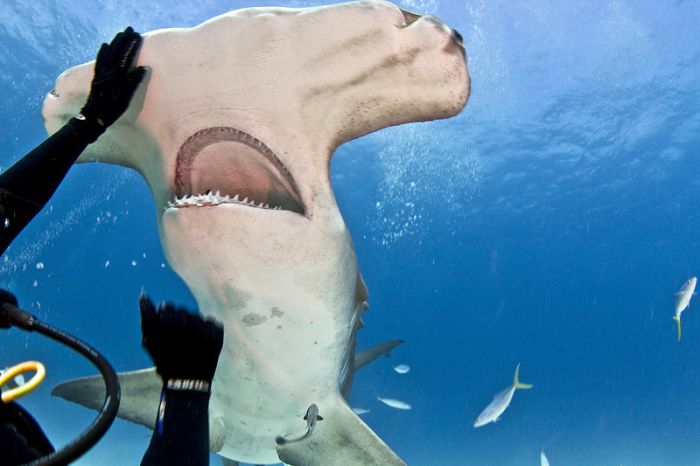|
|
Diver Feeding Great Hammerhead Shark
|
The great hammerhead is a solitary, nomadic predator that tends to be given a wide berth by other reef sharks. If confronted, they may respond with an agonistic display: dropping their pectoral fins and swimming in a stiff or jerky fashion. Juveniles are preyed upon by larger sharks such as bull sharks (Carcharhinus leucas), while adults have no major predators. Yellow jacks (Carangoides bartholomaei) have been seen rubbing themselves against the hammerhead's flanks, possibly to rid themselves of parasites. Schools of pilot fish (Naucrates ductor) sometimes accompany the great hammerhead. The great hammerhead is parasitized by several species of copepods, including Alebion carchariae, A. elegans, Nesippus orientalis, N. crypturus, Eudactylina pollex, Kroyeria gemursa, and Nemesis atlantica.
• Feeding
An active predator with a varied diet, known prey of the great hammerhead include invertebrates such as crabs, lobsters, squid, and octopus, bony fishes such as tarpon, sardines, sea catfishes, toadfish, porgies, grunts, jacks, croakers, groupers, flatfishes, boxfishes, and porcupine fishes, and smaller sharks such as smoothhounds. At Rangiroa Atoll, great hammerheads prey opportunistically on grey reef sharks (Carcharhinus amblyrhynchos) that have exhausted themselves pursuing mates. The species is known to be cannibalistic.
The favorite prey of the great hammerhead are rays and skates, especially stingrays. The venomous spines of stingrays are frequently found lodged inside its mouth and do not seem to bother the shark as one specimen caught off Florida had 96 spines in and around its mouth. Great hammerheads primarily hunt at dawn or dusk, swinging their heads in broad angles over the sea floor so as to pick up the electrical signatures of stingrays buried in the sand, via numerous ampullae of Lorenzini located on the underside of the cephalofoil. The cephalofoil also serves as a hydrofoil that allows the shark to quickly turn around and strike at a ray once detected. Off Florida, large hammerheads are often the first to reach newly baited sharklines, suggesting a particularly keen sense of smell.
|
|









